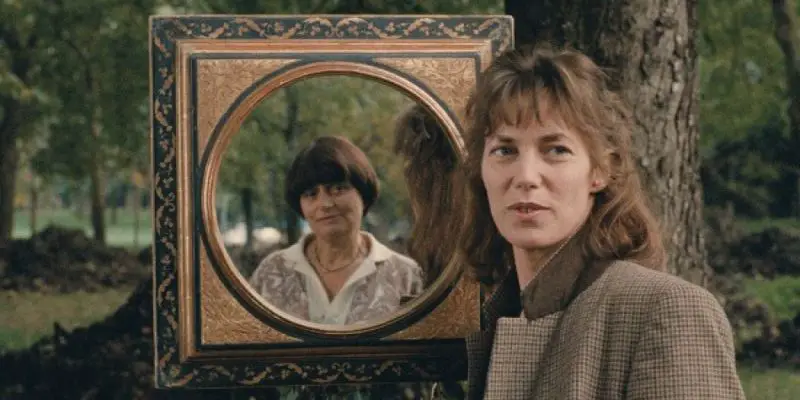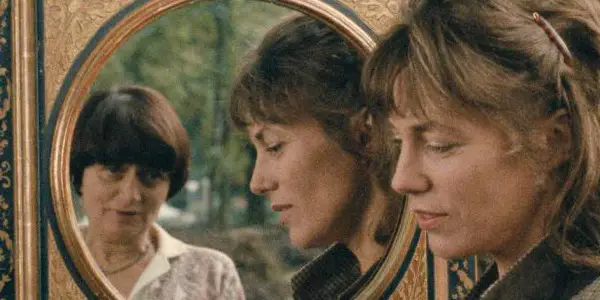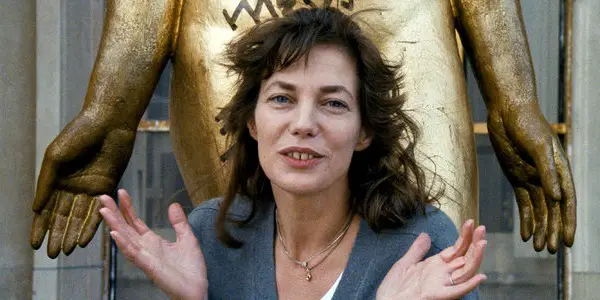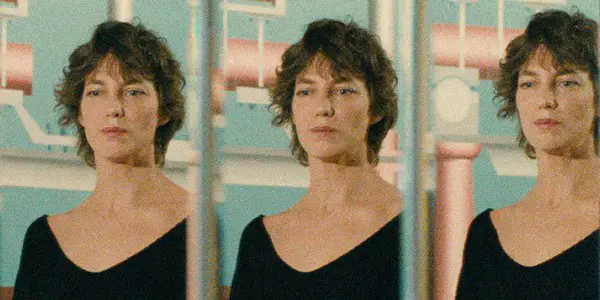JANE B. PAR AGNÈS V.: Personal Observations On A Public Life

Bethan Highgate-Betts is a freelance writer and film maker from…
First released with Kung-Fu Master! in 1988, Jane B. Par Agnès V. is a collaboration between seminal French filmmaker and the “Grandmother of French New Wave cinema” Agnès Varda and actress and singer Jane Birkin. Encompassing documentary and fiction, it is a sort of love story to a life that is both private and public.
A collaboration in every sense of the word, the film has both the subject and director sharing the screen and driving the narrative with open discussion. A portrait of Birkin’s life, some of it real, some of it imagined, often punctuated by re-played out scenes from and discussion of Kung-Fu Masters!. It is presented as a documentary about Birkin, with unfamiliar stylistic elements to keep us on our toes.
Reflections on a public life
The film has a Freudian-esque obsession with mirrors and the mirrored self; it is less about personal reflection and more about distorted presentation to an outside element. This reflection of public and private life is a big part of Jane B. par Agnès V., as is the effect of Varda being both its lead actor and director.
The film is an exploration of living a life in the public eye and the fantasies – both her own and those of others – that come with that. Often within the film, Birkin speaks of her desire to be liked, describing suffering terrible nightmares where she commits hideous crimes, but upon waking is only scared of what the papers would say about her, that everyone will hate her, and not the crime itself.

She recalls her 30th birthday and an ill-fated bottle of sherry alone in a London hotel room, having had to leave her children in France to shoot a film. This becomes a story of isolation, discomfort and one which is not at all glamorous, yet it’s cleverly juxtaposed with an exquisitely beautiful wide shot of Birkin running down London’s Westminster Bridge, capturing the sky at sunset behind Big Ben. The scene works with the visual perception of beauty and of Birkin’s care-free days in the capital city, and her narration of what the experience was actually like. She depicts the difference of perception and reality in the lives of people in the public eye.
Varda uses Birkin’s life to explore ageing and the passing of time, and at one point, Birkin states “The years with the zeroes at the end hurt the most” and looking back upon her life and relationships. They reflect upon her 13-year relationship with Serge Gainsbourg, and she often described as his muse. Birkin and Varda delve into what this meant at the time, as well as what it means to other people.
Now, muse is a word that I would not be comfortable using to describe any woman’s relationship to a man, but it is one that Birkin uses unabashedly throughout the film. Perhaps it is because my experience of the word comes from the likes of Noah Baumbach and Greta Gerwig; so often we hear Frances Ha and Mistress America described as being made by Baumbach with Gerwig as his muse, never referencing the fact that she co-wrote both films.

This term seems to give the woman less of a part in the production of the piece, it makes her a girl in a painting that has sparked the inspiration of the painter, but has no active role in the ‘making’ process. This uneasy concept is something that Varda and Birkin play with and explore with humour within the film. Acting out scenes and playing with the linguistics that are often used to define Birkin.
An actress, a mother, a portrait
It’s sad to say, but as someone living in the UK and experiencing the media mainly though UK outlets, it was a warm and very welcome change to experience a woman in her 40’s speaking about her children and her work at the same time without being apologetic. From tabloid headlines and trash TV it has become all too familiar and something which is often a little too easy to forget is not necessarily the case. The film is a feminist portrait of women, in so far as the male gaze is taken away.
Jane B. par Agnès V. uses still images often, setting up the beginning of scenes with a recreation of an artwork. This method of real-time painting allows the viewer to adjust from the ‘real-life’ documentary style to imagined element such as the Tarzan and Jane or Joan of Ark set ups. It also allows us to look at the image in more depth. The influence of this style can be seen throughout the more mainstream films of the last 30 years, drawing heavy comparison with Gus Van Saint My Own Private Idaho.

In one shot, Varda follows up over Birkin’s naked body; a complete portrait of a woman, shot like a Renaissance painting. The camera leads the audience, showing us how to view Birkin’s body. Its slow and steady movements work their way up from the cut of her toe nails to her eyes fixing on the lens. There is a vulnerability there, but more so a sense of wanting to be seen, to be looked upon in a way that is completely controlled.
Conclusion
Varda is an astonishing film director and one who’s been praised highly countless times over her 60+ year career. Jane B. par Agnès V. is a digital portrait of a woman and the journey that she is on. It is, stylistically speaking, a challenging watch, simply because the format can be seen as erratic and unfamiliar. But it is a watch that is so rewarding, it is a film that reads as if it were a book, a biography of Jane Birkin and Agnès Varda the author.
Full page spreads of pictures, life and art, interviews, confessions and fantasies; it’s like reading the newspapers Birkin often mentions. Jumping on the page between image and content, seeing the headlines, imagining the reality and hearing the voice behind the pictures. Except, for once, the person in the story and the author are on the journey together.
Often described as a companion piece to Kung-Fu Masters!, would you say the Jane B. par Agnès V. stands its ground alone?
Jane B. par Agnès V. and Kung-Fu Masters! have both been restored by Cinelicious and will be re-released on VOD through Amazon on the 2nd of February 2016. They get a BluRay release on March 8, 2016, as well as VOD release on all other major platforms.
https://www.youtube.com/watch?v=wbhbUoStCg8
Does content like this matter to you?
Become a Member and support film journalism. Unlock access to all of Film Inquiry`s great articles. Join a community of like-minded readers who are passionate about cinema - get access to our private members Network, give back to independent filmmakers, and more.
Bethan Highgate-Betts is a freelance writer and film maker from the UK. She has been commissioned to create short films by organisations such as The BFI, Doc Next Media and Fringe Arts Bath, as well as having her short films screened around the country. She loves watching, writing about and talking about film, and is currently undertaking the Women In Film LA #52FilmsByWomen challenge 2016!












